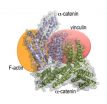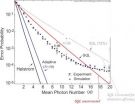(Press-News.org) As they typically result from severe external perturbations, it is of vital interest how stable the most desirable state is. Surprisingly, this basic question has so far received little attention. Now scientists of the Potsdam Institute for Climate Impact Research (PIK), in a paper published in Nature Physics, propose a new concept for quantifying stability.
"Up to now, science was able to say if a complex system is stable or not, but it wasn't able to properly say how stable it is," says Peter J. Menck, lead author of the paper. The proposed concept is the first to fill this gap. "We conceive a system's alternative states as points in a mountainous landscape with steep rocks and deep valleys," explains Menck. "In the sinks between the peaks, a system comes to rest like a rolling ball would. Now the likelihood that the system returns to a specific sink after suffering a severe blow strongly depends on how big the surrounding valley is." In the high-dimensional systems Menck and his colleagues study, the equivalent of the valley is called the basin of attraction. The basin's volume is the measure the authors suggest to use for the quantification of stability.
Getting the actual data still is a challenge
The authors envision the new concept to become a powerful tool for complex systems studies, including the assessment of climatic tipping elements like the Amazon rainforest. Under unabated global warming, this ecosystem might change from its present fertile forest state to a much drier savanna state. Such a transition would destroy one of the planet's most important CO2 sinks, thus contributing to further climate change. "Amazonian bistability arises from a positive feedback: Deep-rooting trees take up water and transpire it to the atmosphere" Menck says. Forest cover in the region increases overall rainfall and thereby improves its own growing conditions. If the forest cover gets pushed below a certain threshold, this mechanism doesn't work any more – the rainforest would die.
The "basin stability concept" is apt for quantifying this risk. However, it is critical to actually do this from measured data. "Other researchers recently have collected the characteristics in terms of precipitation, temperature, soil of rainforests and savannas under defined climatological conditions," Menck says. Still, the assessment is extremely challenging as the tipping of a forest is a rare event, so observation data is scarce. In contrast, observation data of human cells changing from a healthy state to cancer can be abundant. "So medical researchers told us that our concept could be quite helpful in better assessing the risk of sane cells to turning sick when disturbed by specific exogenous factors."
"Simple yet compelling – that's the way fundamental physics looks like"
Power grids have to function in good synchronization to assure that lights can be switched on everywhere anytime. Previous theory suggested that this should most easily be achieved if power grids had what researchers call a random structure, which in fact would yield many short-cuts between distant nodes. Yet in reality, grids look far more regular. Applying the basin stability concept shows why that is: In more regular grids, the desired synchronous state possesses a far bigger 'basin', hence is much more stable against perturbations.
"The basin stability's applicability to high-dimensional systems allowed us to solve a puzzle that has long haunted complex network science," says Jürgen Kurths, a co-author of the paper and co-chair of PIK's research domain 'Transdisciplinary concepts and methods'. "Our new nonlinear approach jumps from a local to a whole system analysis, thus complementing previous research mostly based on linearization. This new concept is simple, yet compelling – that's the way fundamental physics looks like."
###
Article: Menck, P.J., Heitzig, J., Marwan, N., Kurths, J. (2013): How basin stability complements the linear-stability paradigm. Nature Physics (advance online publication) [doi:10.1038/NPHYS2516]
For further information please contact: PIK press office END
The study, published today in Nature Climate Change, is the first of its kind on ice sheet melting to use structured expert elicitation (EE) together with an approach which mathematically pools experts' opinions. EE is already used in a number of other scientific fields such as forecasting volcanic eruptions.
The ice sheets covering Antarctica and Greenland contain about 99.5 per cent of the Earth's glacier ice which would raise global sea level by some 63m if it were to melt completely. The ice sheets are the largest potential source of future sea level rise – and ...
Quebec City & Toronto, January 6, 2013—For individuals with agonizing pain, it is a cruel blow when the gold-standard medication actually causes more pain. Adults and children whose pain gets worse when treated with morphine may be closer to a solution, based on research published in the January 6 on-line edition of Nature Neuroscience.
"Our research identifies a molecular pathway by which morphine can increase pain, and suggests potential new ways to make morphine effective for more patients," says senior author Dr. Yves De Koninck, Professor at Université Laval in ...
JUPITER, FL, January 6, 2012 – Scientists know that cells in all higher organisms cells need to bind to each other for the development, architecture, maintenance and function of tissues. Mysteries have remained, however, about exactly how cells manage this feat.
Scientists from the Florida campus of The Scripps Research Institute (TSRI) have now solved part of this puzzle by defining the structure of a protein known as α-catenin, which is essential to this process.
The work was published online ahead of print on January 6, 2012, by the journal Nature Structural ...
BOSTON – January 8, 2013 -- As part of their ongoing research on the physiologic factors that contribute to the development of obesity, Joslin Diabetes Center scientists have identified a cell cycle transcriptional co-regulator – TRIP-Br2 – that plays a major role in energy metabolism and fat storage. This finding has the potential to lead to new treatments for obesity. The study is being published today ahead of print by Nature Medicine.
Transcriptional co-regulators manage the expression of DNA, either by activating or suppressing the expression of genes. TRIP-Br2 ...
VIDEO:
This movie shows two simulations of planetary system disruption by galactic disturbances to wide binary stars. On the left is a zoomed-out view showing the orbit of a hypothetical 0.1...
Click here for more information.
TORONTO, ON – An international team of astrophysicists has shown that planetary systems with very distant binary stars are particularly susceptible to violent disruptions, more so than if they had stellar companions with tighter orbits around them.
Unlike ...
Technologically valuable ultrastable glasses can be produced in days or hours with properties corresponding to those that have been aged for thousands of years, computational and laboratory studies have confirmed.
Aging makes for higher quality glassy materials because they have slowly evolved toward a more stable molecular condition. This evolution can take thousands or millions of years, but manufacturers must work faster. Armed with a better understanding of how glasses age and evolve, researchers at the universities of Chicago and Wisconsin-Madison raise the possibility ...
Cleaning up mercury pollution and reducing prenatal exposure to the neurotoxin methylmercury (MeHg) could save the European Union €10,000 million per year, finds a new study published in BioMed Central's open access journal Environmental Health. New estimates suggest that between 1.5 and 2 million children in the EU are born each year with MeHg exposures above the safe limit of 0.58µg/g and 200,000 above the WHO recommended maximum of 2.5µg/g.
While some mercury occurs naturally in the environment for example from volcanic eruptions or forest fires, most is generated ...
"That's not what I meant": human communication is fraught with misinterpretation. Written out in longhand, words and letters can be misread. A telegraph clerk can mistake a dot for a dash. Noise will always be with us, but at least a new JQI (*) device has established a new standard for reading quantum information with a minimum of uncertainty.
Success has come by viewing light pulses not with a single passive detector with but an adaptive network of detectors with feedback. The work on JQI's new, more assured photonic protocol was led by Francisco Becerra ...
DEERFIELD, IL-Beak shape variation in Darwin's finches is a classic example of evolutionary adaptation, with beaks that vary widely in proportions and shape, reflecting a diversity of ecologies. While living birds have a beak to manipulate their food, their fossil bird ancestors had teeth. Now a new fossil discovery shows some fossil birds evolved teeth adapted for specialized diets.
A study of the teeth of a new species of early bird, Sulcavis geeorum, published in the latest issue of the Journal of Vertebrate Paleontology, suggests this fossil bird had a durophagous ...
New research reveals a shared genetic susceptibility to epilepsy and migraine. Findings published in Epilepsia, a journal of the International League Against Epilepsy (ILAE), indicate that having a strong family history of seizure disorders increases the chance of having migraine with aura (MA).
Medical evidence has established that migraine and epilepsy often co-occur in patients; this co-occurrence is called "comorbidity." Previous studies have found that people with epilepsy are substantially more likely than the general population to have migraine headache. However, ...





